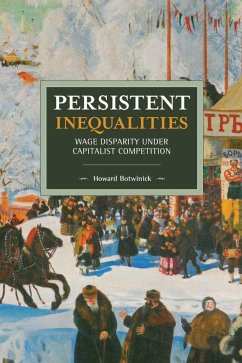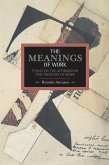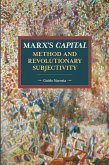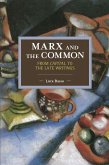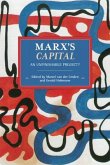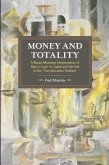- Broschiertes Buch
- Merkliste
- Auf die Merkliste
- Bewerten Bewerten
- Teilen
- Produkt teilen
- Produkterinnerung
- Produkterinnerung
Botwinick provocatively shows that competition and technical change often militate against wage equalization, and calls for militant union organization that can once again take wages and working conditions out of capitalist competition.
Andere Kunden interessierten sich auch für
![The Meanings of Work The Meanings of Work]() Ricardo AntunesThe Meanings of Work32,99 €
Ricardo AntunesThe Meanings of Work32,99 €![Marxism in a Lost Century Marxism in a Lost Century]() Gary RothMarxism in a Lost Century32,99 €
Gary RothMarxism in a Lost Century32,99 €![Marx's Capital, Method and Revolutionary Subjectivity Marx's Capital, Method and Revolutionary Subjectivity]() Guido StarostaMarx's Capital, Method and Revolutionary Subjectivity31,99 €
Guido StarostaMarx's Capital, Method and Revolutionary Subjectivity31,99 €![Marx and the Common Marx and the Common]() Luca BassoMarx and the Common31,99 €
Luca BassoMarx and the Common31,99 €![Marx's Capital Marx's Capital]() Marx's Capital32,99 €
Marx's Capital32,99 €![Immanent Externalities Immanent Externalities]() Rebecca CarsonImmanent Externalities28,99 €
Rebecca CarsonImmanent Externalities28,99 €![Money and Totality Money and Totality]() Fred MoseleyMoney and Totality42,99 €
Fred MoseleyMoney and Totality42,99 €-
-
-
Botwinick provocatively shows that competition and technical change often militate against wage equalization, and calls for militant union organization that can once again take wages and working conditions out of capitalist competition.
Hinweis: Dieser Artikel kann nur an eine deutsche Lieferadresse ausgeliefert werden.
Hinweis: Dieser Artikel kann nur an eine deutsche Lieferadresse ausgeliefert werden.
Produktdetails
- Produktdetails
- Verlag: Haymarket Books
- Seitenzahl: 390
- Erscheinungstermin: 11. Dezember 2018
- Englisch
- Abmessung: 224mm x 152mm x 23mm
- Gewicht: 499g
- ISBN-13: 9781608460199
- ISBN-10: 1608460193
- Artikelnr.: 50988985
- Herstellerkennzeichnung
- Libri GmbH
- Europaallee 1
- 36244 Bad Hersfeld
- gpsr@libri.de
- Verlag: Haymarket Books
- Seitenzahl: 390
- Erscheinungstermin: 11. Dezember 2018
- Englisch
- Abmessung: 224mm x 152mm x 23mm
- Gewicht: 499g
- ISBN-13: 9781608460199
- ISBN-10: 1608460193
- Artikelnr.: 50988985
- Herstellerkennzeichnung
- Libri GmbH
- Europaallee 1
- 36244 Bad Hersfeld
- gpsr@libri.de
Howard Botwinick, Ph.D. (1985) New School for Social Research, is Associate Professor of Economics at SUNY Cortland. He has been active in several unions and was a founding member of the U.S. Labor Party in the 1990s.
New Preface (2017 Edition)
Preface and Acknowledgements (1993 Edition)
List of Figures
List of Tables
1 Introduction
Breaking the Impasse
Toward a Theoretical Alternative
Implications for the Analysis of Discrimination
On Heterogeneous Labour
Comparing Our Results to Orthodox and Radical Economics
Solving Some Anomalies
Outline of the Argument
2 Continuing Attempts to Square the Circle (Or, Competitive Theory
Confronts Differential Wage Rates)
Early Neoclassical Wage Theory
The Theory of Perfect Competition: Abstraction as Idealisation
The Inevitable Schism between Theory and Practice
The Theory of Imperfect Competition – Godsend or Albatross?
Postwar Institutionalists: An Initial Attempt at Alternative Theory
The Ascent of Human Capital Theory
The Real World Strikes Back
The New Institutionalists: The Dual Economy and Dual Labour Markets
Labour Market Segmentation and Monopoly Capital
The Initial Response to Segmentation Theory
The Second Wave of Segmentation Arguments
The Continuing Search for a Radical Alternative
Efficiency Wage Theory: The Latest Attempt to Square the Circle
3 Capitalist Accumulation and the Aggregate Labour Market
Marx versus Neoclassical Economics
The Special Commodity Labour Power
Primitive Accumulation and the ‘Doubly Free’ Labourer
The Unique Logic of Labour Supply
Capitalist Accumulation and the Reserve Army of Labour
Marx’s Reserve Army within the Modern Period
On the Necessity of Worker Resistance
Capitalist Accumulation and the Limits to Rising Wage Rates
Empirical Evidence for Limits to Rising Wage Rates
4 Wage Differentials and the Aggregate Labour Market
Capitalism’s Active and Reserve Armies: Differentiation and ‘Segmentation’
in Their Most Basic Forms
The Role of Workers in the Segmentation Process
A Dynamic Analysis of Labour Mobility and Wage Differentiation Under
Conditions of Permanent Underemployment
Uneven Technical Change, Competition, and the Reserve Army: A Brief
Glimpse of Marx’s Theory of Wage Differentials
On the Incompleteness of Marx’s Work
5 Capitalist Competition and Differential Profit Rates
Competition within Industries
Competition between Industries
Marx’s Concept of Regulating Capitals
Empirical Evidence of Monopoly
Chapter Summary
Appendix to Chapter 5
6 Capitalist Competition and Differential Wage Rates (I): The Analysis of
Regulating Capitals
Overview of the Dynamic Adjustment to Changing Wage Rates
Deriving Determinate Limits to Rising Wage Rates
Limit One: The Immediate Profitability of Regulating Capitals
Limit Two: The Unit Costs of Subdominant Capitals
Further Implications for Inter- and Intraindustry Wage Patterns
Limit Three: The Differential Costs of Obstructing Wage Increases
Analysing the Effects of Uneven Worker Organisation
A Final Note on Workers’ Power and the Costs of Obstruction
The General Laws of Capitalist Accumulation
7 Capitalist Competition and Differential Wage Rates (II): Non-regulating
Capitals and Differential Profit Rates
The Case of Less Efficient Capitals
Short-Term Effects of Rising Wage Rates
The Case of More Efficient Capitals
Implications of the Dynamic Equalisation of Profit Rates
Conclusion
Capitalist Competition and Differential Wage Rates: Abundant Possibilities
for Sustained Inequality
Capitalist Accumulation and the Aggregate Labour Market: Further Sources
of Wage Variation
Comparing Our Results to Neoclassical Economics
Comparing Our Results to Radical Economics
Implications for Empirical Research
Implications for the Contemporary Labour Movement
Afterword: The Past 20 Years Have Not Been Pretty
Where Do We Go from Here? Lessons from the 1930s
But Hasn’t Accelerated Globalisation Made the Old CIO Strategies Obsolete?
Given the Dismal State of the Left, How Can We Get There from Here? A
Final Lesson from the 1930s
References
Index
Preface and Acknowledgements (1993 Edition)
List of Figures
List of Tables
1 Introduction
Breaking the Impasse
Toward a Theoretical Alternative
Implications for the Analysis of Discrimination
On Heterogeneous Labour
Comparing Our Results to Orthodox and Radical Economics
Solving Some Anomalies
Outline of the Argument
2 Continuing Attempts to Square the Circle (Or, Competitive Theory
Confronts Differential Wage Rates)
Early Neoclassical Wage Theory
The Theory of Perfect Competition: Abstraction as Idealisation
The Inevitable Schism between Theory and Practice
The Theory of Imperfect Competition – Godsend or Albatross?
Postwar Institutionalists: An Initial Attempt at Alternative Theory
The Ascent of Human Capital Theory
The Real World Strikes Back
The New Institutionalists: The Dual Economy and Dual Labour Markets
Labour Market Segmentation and Monopoly Capital
The Initial Response to Segmentation Theory
The Second Wave of Segmentation Arguments
The Continuing Search for a Radical Alternative
Efficiency Wage Theory: The Latest Attempt to Square the Circle
3 Capitalist Accumulation and the Aggregate Labour Market
Marx versus Neoclassical Economics
The Special Commodity Labour Power
Primitive Accumulation and the ‘Doubly Free’ Labourer
The Unique Logic of Labour Supply
Capitalist Accumulation and the Reserve Army of Labour
Marx’s Reserve Army within the Modern Period
On the Necessity of Worker Resistance
Capitalist Accumulation and the Limits to Rising Wage Rates
Empirical Evidence for Limits to Rising Wage Rates
4 Wage Differentials and the Aggregate Labour Market
Capitalism’s Active and Reserve Armies: Differentiation and ‘Segmentation’
in Their Most Basic Forms
The Role of Workers in the Segmentation Process
A Dynamic Analysis of Labour Mobility and Wage Differentiation Under
Conditions of Permanent Underemployment
Uneven Technical Change, Competition, and the Reserve Army: A Brief
Glimpse of Marx’s Theory of Wage Differentials
On the Incompleteness of Marx’s Work
5 Capitalist Competition and Differential Profit Rates
Competition within Industries
Competition between Industries
Marx’s Concept of Regulating Capitals
Empirical Evidence of Monopoly
Chapter Summary
Appendix to Chapter 5
6 Capitalist Competition and Differential Wage Rates (I): The Analysis of
Regulating Capitals
Overview of the Dynamic Adjustment to Changing Wage Rates
Deriving Determinate Limits to Rising Wage Rates
Limit One: The Immediate Profitability of Regulating Capitals
Limit Two: The Unit Costs of Subdominant Capitals
Further Implications for Inter- and Intraindustry Wage Patterns
Limit Three: The Differential Costs of Obstructing Wage Increases
Analysing the Effects of Uneven Worker Organisation
A Final Note on Workers’ Power and the Costs of Obstruction
The General Laws of Capitalist Accumulation
7 Capitalist Competition and Differential Wage Rates (II): Non-regulating
Capitals and Differential Profit Rates
The Case of Less Efficient Capitals
Short-Term Effects of Rising Wage Rates
The Case of More Efficient Capitals
Implications of the Dynamic Equalisation of Profit Rates
Conclusion
Capitalist Competition and Differential Wage Rates: Abundant Possibilities
for Sustained Inequality
Capitalist Accumulation and the Aggregate Labour Market: Further Sources
of Wage Variation
Comparing Our Results to Neoclassical Economics
Comparing Our Results to Radical Economics
Implications for Empirical Research
Implications for the Contemporary Labour Movement
Afterword: The Past 20 Years Have Not Been Pretty
Where Do We Go from Here? Lessons from the 1930s
But Hasn’t Accelerated Globalisation Made the Old CIO Strategies Obsolete?
Given the Dismal State of the Left, How Can We Get There from Here? A
Final Lesson from the 1930s
References
Index
New Preface (2017 Edition)
Preface and Acknowledgements (1993 Edition)
List of Figures
List of Tables
1 Introduction
Breaking the Impasse
Toward a Theoretical Alternative
Implications for the Analysis of Discrimination
On Heterogeneous Labour
Comparing Our Results to Orthodox and Radical Economics
Solving Some Anomalies
Outline of the Argument
2 Continuing Attempts to Square the Circle (Or, Competitive Theory
Confronts Differential Wage Rates)
Early Neoclassical Wage Theory
The Theory of Perfect Competition: Abstraction as Idealisation
The Inevitable Schism between Theory and Practice
The Theory of Imperfect Competition – Godsend or Albatross?
Postwar Institutionalists: An Initial Attempt at Alternative Theory
The Ascent of Human Capital Theory
The Real World Strikes Back
The New Institutionalists: The Dual Economy and Dual Labour Markets
Labour Market Segmentation and Monopoly Capital
The Initial Response to Segmentation Theory
The Second Wave of Segmentation Arguments
The Continuing Search for a Radical Alternative
Efficiency Wage Theory: The Latest Attempt to Square the Circle
3 Capitalist Accumulation and the Aggregate Labour Market
Marx versus Neoclassical Economics
The Special Commodity Labour Power
Primitive Accumulation and the ‘Doubly Free’ Labourer
The Unique Logic of Labour Supply
Capitalist Accumulation and the Reserve Army of Labour
Marx’s Reserve Army within the Modern Period
On the Necessity of Worker Resistance
Capitalist Accumulation and the Limits to Rising Wage Rates
Empirical Evidence for Limits to Rising Wage Rates
4 Wage Differentials and the Aggregate Labour Market
Capitalism’s Active and Reserve Armies: Differentiation and ‘Segmentation’
in Their Most Basic Forms
The Role of Workers in the Segmentation Process
A Dynamic Analysis of Labour Mobility and Wage Differentiation Under
Conditions of Permanent Underemployment
Uneven Technical Change, Competition, and the Reserve Army: A Brief
Glimpse of Marx’s Theory of Wage Differentials
On the Incompleteness of Marx’s Work
5 Capitalist Competition and Differential Profit Rates
Competition within Industries
Competition between Industries
Marx’s Concept of Regulating Capitals
Empirical Evidence of Monopoly
Chapter Summary
Appendix to Chapter 5
6 Capitalist Competition and Differential Wage Rates (I): The Analysis of
Regulating Capitals
Overview of the Dynamic Adjustment to Changing Wage Rates
Deriving Determinate Limits to Rising Wage Rates
Limit One: The Immediate Profitability of Regulating Capitals
Limit Two: The Unit Costs of Subdominant Capitals
Further Implications for Inter- and Intraindustry Wage Patterns
Limit Three: The Differential Costs of Obstructing Wage Increases
Analysing the Effects of Uneven Worker Organisation
A Final Note on Workers’ Power and the Costs of Obstruction
The General Laws of Capitalist Accumulation
7 Capitalist Competition and Differential Wage Rates (II): Non-regulating
Capitals and Differential Profit Rates
The Case of Less Efficient Capitals
Short-Term Effects of Rising Wage Rates
The Case of More Efficient Capitals
Implications of the Dynamic Equalisation of Profit Rates
Conclusion
Capitalist Competition and Differential Wage Rates: Abundant Possibilities
for Sustained Inequality
Capitalist Accumulation and the Aggregate Labour Market: Further Sources
of Wage Variation
Comparing Our Results to Neoclassical Economics
Comparing Our Results to Radical Economics
Implications for Empirical Research
Implications for the Contemporary Labour Movement
Afterword: The Past 20 Years Have Not Been Pretty
Where Do We Go from Here? Lessons from the 1930s
But Hasn’t Accelerated Globalisation Made the Old CIO Strategies Obsolete?
Given the Dismal State of the Left, How Can We Get There from Here? A
Final Lesson from the 1930s
References
Index
Preface and Acknowledgements (1993 Edition)
List of Figures
List of Tables
1 Introduction
Breaking the Impasse
Toward a Theoretical Alternative
Implications for the Analysis of Discrimination
On Heterogeneous Labour
Comparing Our Results to Orthodox and Radical Economics
Solving Some Anomalies
Outline of the Argument
2 Continuing Attempts to Square the Circle (Or, Competitive Theory
Confronts Differential Wage Rates)
Early Neoclassical Wage Theory
The Theory of Perfect Competition: Abstraction as Idealisation
The Inevitable Schism between Theory and Practice
The Theory of Imperfect Competition – Godsend or Albatross?
Postwar Institutionalists: An Initial Attempt at Alternative Theory
The Ascent of Human Capital Theory
The Real World Strikes Back
The New Institutionalists: The Dual Economy and Dual Labour Markets
Labour Market Segmentation and Monopoly Capital
The Initial Response to Segmentation Theory
The Second Wave of Segmentation Arguments
The Continuing Search for a Radical Alternative
Efficiency Wage Theory: The Latest Attempt to Square the Circle
3 Capitalist Accumulation and the Aggregate Labour Market
Marx versus Neoclassical Economics
The Special Commodity Labour Power
Primitive Accumulation and the ‘Doubly Free’ Labourer
The Unique Logic of Labour Supply
Capitalist Accumulation and the Reserve Army of Labour
Marx’s Reserve Army within the Modern Period
On the Necessity of Worker Resistance
Capitalist Accumulation and the Limits to Rising Wage Rates
Empirical Evidence for Limits to Rising Wage Rates
4 Wage Differentials and the Aggregate Labour Market
Capitalism’s Active and Reserve Armies: Differentiation and ‘Segmentation’
in Their Most Basic Forms
The Role of Workers in the Segmentation Process
A Dynamic Analysis of Labour Mobility and Wage Differentiation Under
Conditions of Permanent Underemployment
Uneven Technical Change, Competition, and the Reserve Army: A Brief
Glimpse of Marx’s Theory of Wage Differentials
On the Incompleteness of Marx’s Work
5 Capitalist Competition and Differential Profit Rates
Competition within Industries
Competition between Industries
Marx’s Concept of Regulating Capitals
Empirical Evidence of Monopoly
Chapter Summary
Appendix to Chapter 5
6 Capitalist Competition and Differential Wage Rates (I): The Analysis of
Regulating Capitals
Overview of the Dynamic Adjustment to Changing Wage Rates
Deriving Determinate Limits to Rising Wage Rates
Limit One: The Immediate Profitability of Regulating Capitals
Limit Two: The Unit Costs of Subdominant Capitals
Further Implications for Inter- and Intraindustry Wage Patterns
Limit Three: The Differential Costs of Obstructing Wage Increases
Analysing the Effects of Uneven Worker Organisation
A Final Note on Workers’ Power and the Costs of Obstruction
The General Laws of Capitalist Accumulation
7 Capitalist Competition and Differential Wage Rates (II): Non-regulating
Capitals and Differential Profit Rates
The Case of Less Efficient Capitals
Short-Term Effects of Rising Wage Rates
The Case of More Efficient Capitals
Implications of the Dynamic Equalisation of Profit Rates
Conclusion
Capitalist Competition and Differential Wage Rates: Abundant Possibilities
for Sustained Inequality
Capitalist Accumulation and the Aggregate Labour Market: Further Sources
of Wage Variation
Comparing Our Results to Neoclassical Economics
Comparing Our Results to Radical Economics
Implications for Empirical Research
Implications for the Contemporary Labour Movement
Afterword: The Past 20 Years Have Not Been Pretty
Where Do We Go from Here? Lessons from the 1930s
But Hasn’t Accelerated Globalisation Made the Old CIO Strategies Obsolete?
Given the Dismal State of the Left, How Can We Get There from Here? A
Final Lesson from the 1930s
References
Index

